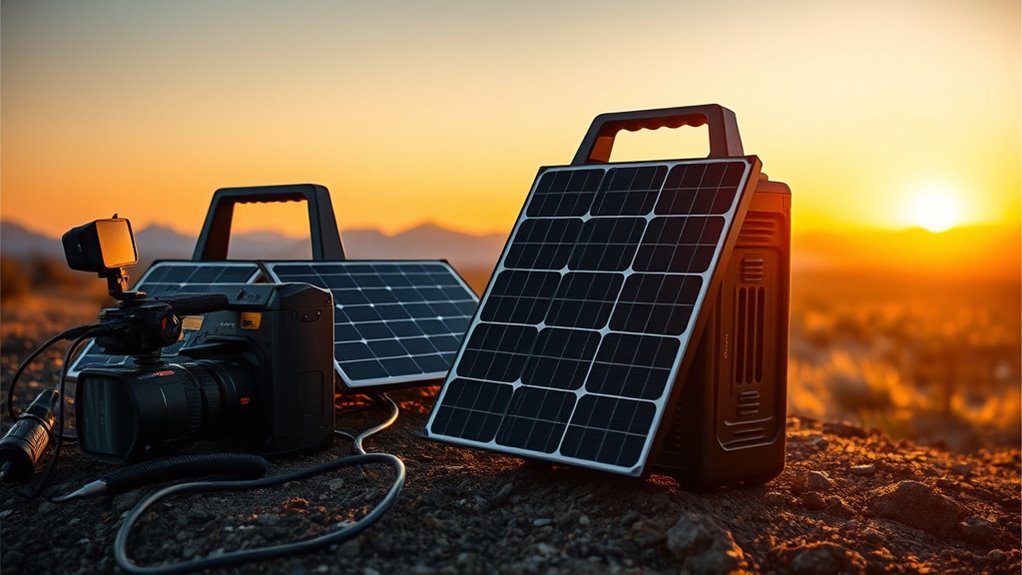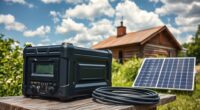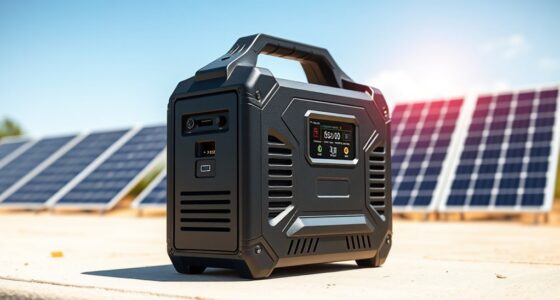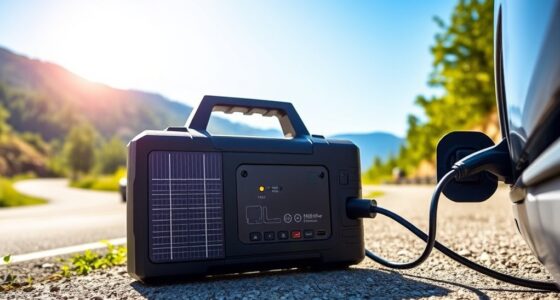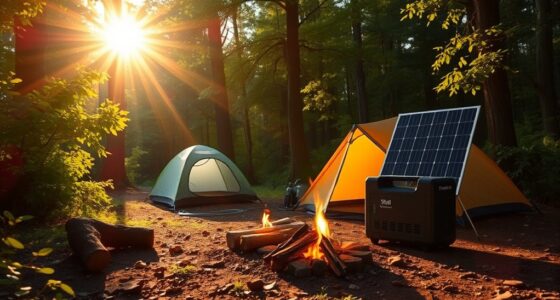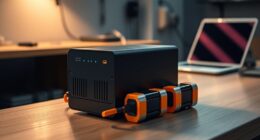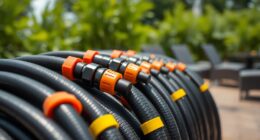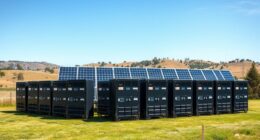When filming in remote locations without grid access, reliable solar generators are your best bet for portable power. They let you run cameras, lights, and other gear efficiently and independently, even under cloudy skies or extended shoots. Look for lightweight, compact models with ample battery capacity, multiple output options, and easy monitoring features. By choosing the right unit, you can guarantee your equipment stays powered on demanding shoots—discover more tips and options to optimize your setup.
Key Takeaways
- Choose solar generators with sufficient battery capacity to power cameras, lights, and accessories during extended remote shoots.
- Prioritize portable, lightweight units with rugged designs and handles for easy transport in challenging environments.
- Ensure compatibility with your equipment by checking available output options like AC outlets and USB ports.
- Monitor power levels via built-in displays or mobile apps to manage energy use efficiently on location.
- Consider modular systems for expandability, allowing additional batteries or solar panels for longer filming sessions.
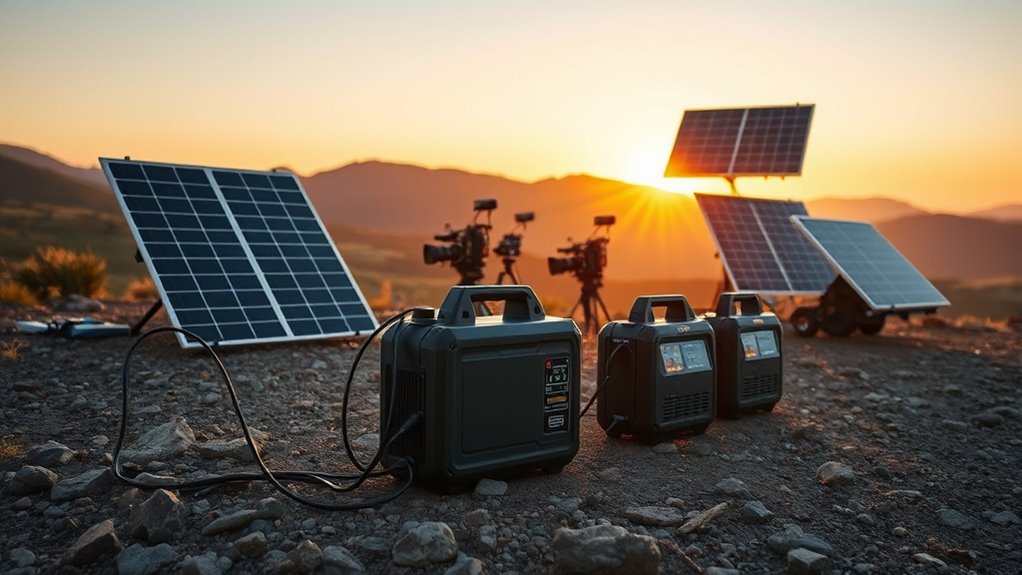
When filming in remote locations, reliable power sources are essential, and solar generators offer an efficient solution. These portable power units allow you to operate cameras, lights, and other equipment without being tethered to grid power. As you contemplate different models, one key factor is battery efficiency. A solar generator’s battery efficiency determines how well it stores and converts solar energy into usable power. Higher efficiency batteries mean you can store more energy from limited sunlight, ensuring your gear stays operational longer. This is especially important when shooting in areas with unpredictable weather or limited sunlight, as you want to maximize the energy you gather during the day. Additionally, look for generators with advanced battery management systems that help prolong battery life and improve overall efficiency, saving you money and hassle over time.
Portability considerations are equally crucial when choosing a solar generator for remote shoots. You’ll want a unit that’s lightweight enough to carry easily across rugged terrain but still robust enough to handle your power needs. Many models are designed with compact form factors and integrated handles, making them easier to transport. Keep in mind that the size and weight of the generator can impact your setup speed and logistical planning, so balance capacity with portability. For extended shoots, consider modular systems that can be expanded with additional batteries or panels, giving you flexibility without sacrificing mobility. Also, think about how you’ll charge the generator—some models come with built-in handles, wheels, or backpack straps to facilitate quick setup and breakdown.
Another aspect to consider is how well the solar generator adapts to your specific equipment. Check the number and types of outputs—USB ports, AC outlets, DC connections—and ensure they match your gear’s power requirements. The ability to monitor power levels easily, either through a digital display or an app, can help you manage energy consumption more efficiently during your shoot. Remember, the best solar generator for remote filmmaking strikes a balance between battery efficiency and portability, providing reliable, clean power without adding unnecessary weight or bulk to your gear. This way, you’re free to focus on capturing your footage, confident that your power source is sturdy, efficient, and tailored to your needs.
Furthermore, exploring top-rated anime movies can provide inspiring visual storytelling techniques that might enhance your filmmaking approach.
Frequently Asked Questions
How Long Do Solar Generators Typically Last on a Single Charge?
You wonder how long a solar generator lasts on a single charge. It depends on its battery capacity and how many charging cycles it can handle. Typically, a well-made generator with a high capacity can power your equipment for several hours or even days, depending on usage. Keep in mind, batteries degrade over time, so after many charging cycles, their performance might decline, reducing runtime.
Can Solar Generators Power High-Energy Equipment Like Drones or Large Monitors?
You might wonder if solar generators can power high-energy equipment like drones or large monitors. With the right solar power system, it’s possible, but it depends on the generator’s energy capacity. Larger models with higher energy capacity can handle these devices, especially if they have sufficient output wattage. Always verify the solar generator’s specifications to ensure it can meet the power demands of your high-energy equipment.
Are Solar Generators Suitable for Extreme Weather Conditions During Shoots?
You wonder if solar generators can handle extreme weather conditions during shoots. While many models offer weather resilience, not all are designed for extreme conditions like heavy rain, snow, or high winds. It’s essential to choose a rugged, weatherproof solar generator built for durability. If you plan shoots in harsh environments, look for one with proper insulation and sturdy casing, ensuring reliable power even under extreme conditions.
What Maintenance Is Required to Keep Solar Generators Functioning Optimally?
Think of your solar generator as a well-tuned orchestra—requiring harmony for peak performance. You should regularly calibrate the battery to guarantee accurate power readings and prevent unexpected shutdowns. Dust prevention is equally crucial; keep vents and panels clean to avoid overheating. Additionally, check connections and store it in a dry, cool place when not in use. Consistent maintenance keeps your power source reliable, ready to spring into action when needed.
How Do Solar Generators Compare in Cost-Effectiveness to Traditional Fuel Generators?
You’ll find solar generators more cost-effective over time compared to traditional fuel generators. They offer significant cost savings on fuel and maintenance, reducing ongoing expenses. Plus, solar generators have a lower environmental impact, helping you cut emissions and reliance on fossil fuels. While initial costs may be higher, their long-term savings and eco-friendly benefits make them a smart, sustainable choice for powering your remote film shoots.
Conclusion
When you choose a solar generator for your remote film shoot, you’re unleashing unlimited power potential—like having the sun itself on your side. These portable power sources keep your cameras and lights running smoothly, even in the most isolated locations. Don’t let limited access to electricity stifle your creativity; with a solar generator, you’ll have endless energy at your fingertips. Embrace this game-changing tech and make your film dreams brighter than ever!
